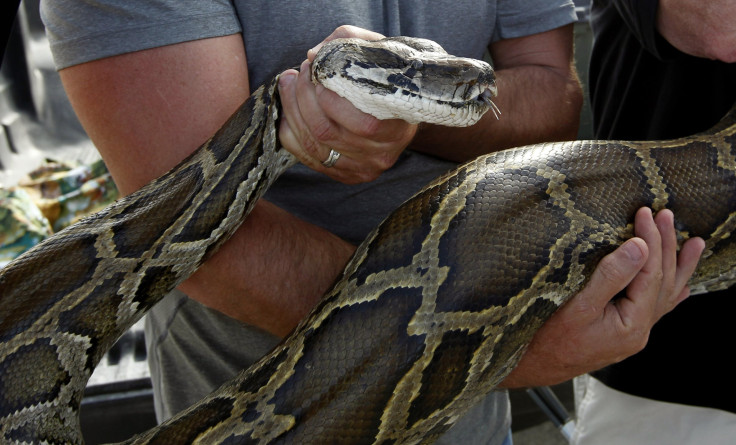Florida Python Invasion: ‘No Going Back’ As Snake Population Spirals Out Of Control

They’re excellent concealers, voracious eaters and prolific breeders – and they might be here to stay. Florida’s invasive Burmese pythons, which have become as much a symbol of Florida’s raw and untamed wilderness as they have a pest, pose a grave threat to the ecosystem as scientists say their population is spiraling out of control. Today, there are simply too many snakes for the species native to Asia ever to be eradicated in the U.S., according to new research by scientists with the U.S. Geological Survey.
The study, published this month in the journal Animal Biotelemetry, is the most comprehensive study yet on Florida python behavior and range, pulling together five years of tracking data to pinpoint where the pythons might reside. Researchers found that the pythons tend to cluster around coastal areas and sloughs, or swamps, and almost always prefer areas with dense tree coverage.
Ecologists hope to use the data to better control the python explosion that has been decimating some small mammal populations. "These high-use areas may be optimal locations for control efforts and further studies on the snakes' potential impacts on native wildlife," Kristen Hart, a USGS research ecologist and lead author of the study, said in a statement. Hunters from all over the country have flocked to Florida in recent years to take part in state-sanctioned python hunts, but finding the snakes has often proved difficult. "Understanding habitat-use patterns of invasive species can aid resource managers in designing appropriately timed and scaled management strategies to help control their spread,” said Hart.
Researchers spent five years tracking 50 snakes implanted with GPS tags. They’ve estimated that there are roughly 300,000 pythons living in Florida. Most are found throughout Everglades National Park and the Southern Glades Wildlife and Environmental Area in the southern part of the state. While most of the pythons measure between 6 and 10 feet in length when full grown, they’ve been known to grow to up to 19 feet and weigh nearly 200 pounds, according to the Florida Fish and Wildlife Conservation Commission. They feed on small mammals, birds and reptiles, including federally listed endangered species like the Key Largo woodrat. The pythons have even been known to devour deer and alligators, as well.
The exotic python has no natural predators in Florida, so its population has been allowed to grow unchecked. Female pythons lay between 50 and 100 eggs at a time.
The pythons are native to Asia and were first spotted in the U.S. in the late 1970s. Many of the snakes were imported as pets. Ecologists have tried everything from poisoning to traps to get rid of them, but to no avail.
Researchers again warned pet owners not to release their snakes into the wild. “We need to get the message out: Don’t let it loose,” Hart told the Miami Herald. “There’s no going back on this one.”
© Copyright IBTimes 2024. All rights reserved.






















